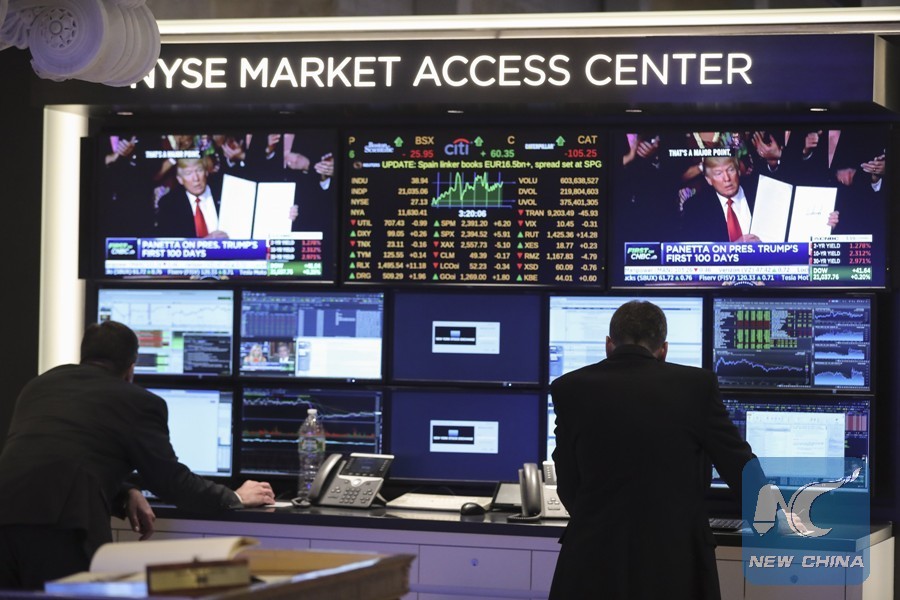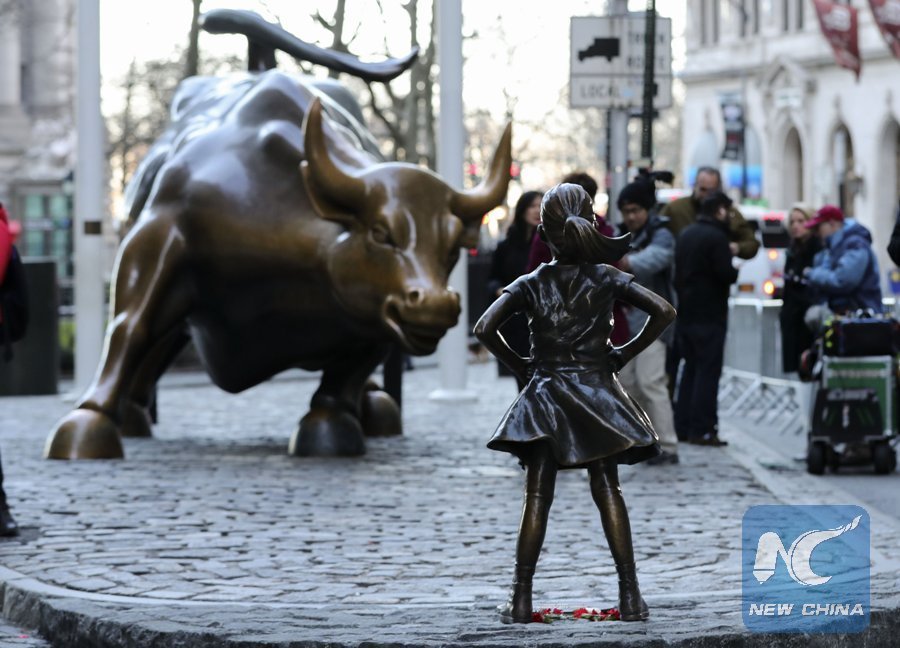
Traders work at the New York Stock Exchange in New York, the United States, on April 26, 2017. (Xinhua/Wang Ying)
by Xinhua Writers Wang Wen, Sun Oumeng
NEW YORK, Dec. 26 (Xinhua) -- U.S. stocks advanced exponentially in 2017, extending a bull market as the Trump administration's tax reform agenda, together with solid economic growth and corporate earnings, has raised investors' spirits around the new year.
The equities were at very important thresholds -- 25,000 on the Dow Jones Industrial Average, 2,700 on the S&P 500, and 7,000 on the Nasdaq Composite Index. While the Dow has climbed up 25.22 percent so far this year, the S&P 500 and the Nasdaq have risen 19.73 percent and 28.85 percent respectively.
The Wall Street has long had a tradition calling the last trading week of the year "Santa rally." But experts saw another "Santa rally" all year-round, fueled by the Trump administration's economic stimulus agenda.

Photo taken on March 9, 2017 shows the "fearless girl" statue facing the bronze bull statue near the Wall Street in New York, the United States. (Xinhua/Wang Ying)
BREAKING RECORDS CONSTANTLY
The Dow closed above the psychological mark of 20,000 points for the first time ever on Jan. 25, when Wall Street believed massive corporate tax cuts and regulatory relief for corporations could come soon.
Investor euphoria was ignited in early March following U.S. President Donald Trump's first address to joint session of Congress. He outlined plans for a trillion-U.S.-dollar infrastructure investment, health care reform, immigration reform and tax relief for businesses and the middle class.
It was widely thought that Trump's speech was fairly conventional, which delivered a desire to move past the turmoil and partisan division rampant in his first month in the White House.
Some analysts said that the absence of protectionist comments as well as an overall tone that was perceived as "presidential" instilled confidence among investors and sent equities higher and higher.
As a result, the Dow topped 21,000 for the first time on March 3, merely 24 trading days after the 20,000 milestone. And then it broke 22,000 on Aug. 2, the third milestone of the year.
At the time, investors were a little disheartened by slow initial progress on Trump's pro-business agenda, but Wall Street's bullish sentiment had not been squashed.
Investors cheered over better-than-expected quarterly corporate earnings reports while being immune to soft economic data and policy uncertainties.
Two months later, investors renewed hopes for a comprehensive tax reform by the end of the year. The Dow notched the fourth thousand-point mark on Oct. 18.
U.S. Treasury Secretary Steven Mnuchin said in the "Politico Money" podcast that the rally in the stock markets had largely been based on expectations of Congress passing a major tax-relief bill, adding that the Wall Street would see a significant drop if the bill was not passed.
Meanwhile, improved earnings and strong international backdrop were beginning to overcome expectations of tax reform, said Humberto Garcia, head of Global Asset Allocation for Bank Leumi USA.
During the first two quarters of the year, earnings surged 15.3 percent and 12.3 percent respectively, according to Thomson Reuters. Earnings of the third and fourth quarters are expected to grow 8.4 percent and 11.7 percent respectively.
FACTORS BEHIND STOCK RALLY
With all three major stock indices hovering at historical highs, investors started asking how much longer U.S. equities could rally.
Some strategists warned about the possible impact the Federal Reserve's move to unwind its 4.5-trillion-dollar balance sheet and raise interest rates might have on the stocks market. The move could lead to excessive tightening, which could stifle consumer confidence and business spending, analysts said.
The Fed started to normalize its balance sheet from October, marking a further step to end its loose monetary policy.
On Nov. 30, the Dow stood above the 24,000 mark and the S&P 500 closed at a record high, triggering another round of debate about whether the equities had higher-than-normal risks.
It was the fifth time that the Dow crossed a 1,000-point mark this year and the index rallied 331.67 points on the day.
The tax reform, along with robust economic data and strong earnings, again stood as the buzz words. But this time experts have noted different factors that have been contributing to the stock rally.
"While investor optimism early in the year focused on the new presidential administration's plans for tax reform, infrastructure spending and deregulation, the more recent exuberance finds support in growing corporate earnings, a strong international backdrop and a steady dovish stance by the Fed," said Garcia.
In the last month of the year, the market focus was pretty much on how tax overhaul could translate into corporate earnings, and the timing and size of future adjustments to U.S. central bank's benchmark interest rates.

U.S. President Donald Trump (C) speaks at an event celebrating the passage of the tax bill on the South Lawn of the White House in Washington D.C., the United States, on Dec. 20, 2017. (Xinhua/Yin Bogu)
On Dec. 22, Trump finally signed a 1.5-trillion-dollar tax cut bill into law. He called it "a bill for the middle class and a bill for jobs," adding that "corporations are literally going wild."
The tax bill, the sweeping rewriting of U.S. tax law since 1986, would cut corporate income tax rate to 21 percent from the current 35 percent and lower individual income rates.
Earnings expectations for next year look decent, but they could be great with tax reform, according to 2018 Market Outlook released by Bank of America Merrill Lynch.
The tax reform could initially add as much as 19 dollars, or 14 percent to S&P 500 earnings per share, including a potential three-dollar benefit from repatriation-induced buy backs, said the bank.
The bank added that the net recurring benefit would more likely be closer to 11 dollars, or 8 percent, because it expected some excess profits to be competed away or passed on to customers.
CAUTINOUS OPTIMISM FOR 2018
Fed officials said at its latest press conference that the central bank envisioned three more rate hikes in 2018. Market analysts and financial institutions had similar projections on the pace of interest rate hikes.
Both Bank of America Merrill Lynch and Morgan Stanley have forecasted three more hikes next year and two more hikes in 2019 in their latest reports.
As for the outlook of the stock market, experts have been cautiously optimistic.
Outgoing Fed Chair Janet Yellen said in her final press briefing that current high stock market valuations do not mean the market was overvalued or that a sell-off would pose much risk to the economy or financial system.
"We are enjoying solid economic growth with low inflation. And the risks to the global economy look more balanced than they have in many years," she said, adding that a low-rate environment was supportive of higher value.
According to Bank of America Merrill Lynch market strategists, sentiment is now a more important driver of the S&P 500 than fundamentals, and sentiment suggests there is still room for stocks to move higher in the near term.
"The Dow should continue to climb in 2018 in light of the recently passed tax legislation in the U.S., which is likely a good sign for a continued strong equities market in 2018," said Garcia.
Market analysts differed in their views of key risks for U.S. equities in 2018.
Bank of America Merrill Lynch considered inflation the top risk.
"Our proprietary indicators suggest that inflationary pressures are building, which could not only hasten the Federal Reserve's tightening but, in a world of scarce pricing power, could pressure corporate margins," the institution said in a report.
It estimated that S&P 500 target at the end of 2018 is 2,800, a 9-percent increase from current levels. By the end of 2025, the S&P 500 will reach 3,500.
Others are more concerned about external factors.
"We see the main risks to economic growth in the coming year to center on exogenous shocks, perhaps instigated by geopolitical events," said Garcia.

